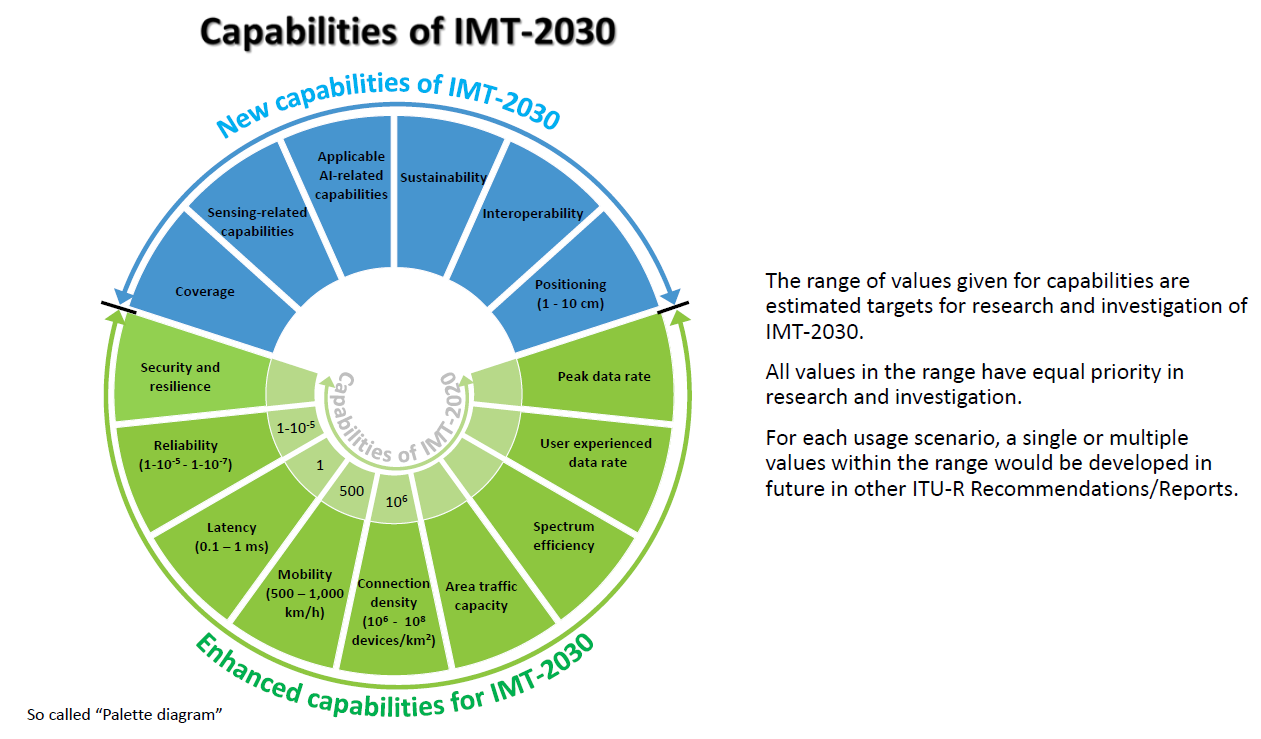Key Objectives of WG Technology Aspects at ITU-R WP 5D meeting June 24-July 3, 2025
ITU-R WP 5D is responsible for the overall radio system aspects of the terrestrial component of International Mobile Telecommunications (IMT) systems, comprising the current IMT-2000, IMT-Advanced and IMT-2020 as well as IMT for 2030 and beyond. Note that 5D’s work is only for terrestrial radio access network interfaces. It does not include 5G or 6G Core network or satellite network access.
ITU-R WP5D Technology Aspects Working Group (WG) consists of several Sub Working Groups (SWGs):
SWG IMT SPECIFICATIONS, SWG EVALUATION, SWG RADIO ASPECTS, SWG IMT UNWANTED EMISSIONS, SWG IMT COORDINATION
Key objectives of WG Technology Aspects at their June 24-July 3, 2025 meeting include:
- Continue revising Recommendation ITU-R M.2150-2 (5G) and Recommendation ITU‑R M.2012-6 (IMT Advanced aka 4G), including consideration of further revision based on contribution;
- Continue working on revision of Document IMT-2030/2 “Process” – submission, evaluation process and consensus building process for IMT-2030;
- Start to work on candidate technology submission template for IMT-2030 (6G);
- Continue working on Report ITU-R M.[IMT-2030.TECH PERF REQ] – minimum requirements related to technical performance for IMT-2030 radio interface(s);
- Continue working on Report ITU-R M.[IMT-2030.EVAL] – Guidelines for evaluation of radio interface technologies for IMT-2030;
- Continue working on Report ITU-R M.[IMT-TROPO DUCT MITIGATION] – Mitigation of interference for IMT network under tropospheric ducting effect;
- Continue working on the documents of unwanted emission characteristics of base/mobile stations using the terrestrial radio interfaces of IMT-2020.
Backgrounder on IMT 2030 (6G):

Recommendation ITU R M.2160 ‒ “Framework and overall objectives of the future development of IMT for 2030 and Beyond” identifies IMT-2030 capabilities which aim to make IMT-2030 (6G) more capable, flexible, reliable and secure than previous IMT systems when providing diverse and novel services in the intended six usage scenarios, including immersive communication, hyper reliable and low latency communication (HRLLC), massive communication, ubiquitous connectivity, artificial intelligence and communication, and integrated sensing and communication (ISAC).
IMT-2030 can be considered from multiple perspectives, including users, manufacturers, application developers, network operators, verticals, and service and content providers. Therefore, it is recognized that technologies for IMT-2030 can be applied in a variety of deployment scenarios and can support a range of environments, service capabilities, and technology options.
IMT-2030 is also expected to be built on overarching aspects which act as design principles commonly applicable to all usage scenarios. These distinguishing design principles of the IMT‑2030 are including, but are not limited to sustainability, security and resilience, connecting the unconnected for providing universal and affordable access to all users independent of the location, and ubiquitous intelligence for improving overall system performance.
………………………………………………………………………………………………………………………………………………………………………………………………………….
References:
ITU-R WP 5D reports on: IMT-2030 (“6G”) Minimum Technology Performance Requirements; Evaluation Criteria & Methodology
Highlights of 3GPP Stage 1 Workshop on IMT 2030 (6G) Use Cases
ITU-R WP 5D reports on: IMT-2030 (“6G”) Minimum Technology Performance Requirements; Evaluation Criteria & Methodology
Ericsson and e& (UAE) sign MoU for 6G collaboration vs ITU-R IMT-2030 framework
ITU-R: IMT-2030 (6G) Backgrounder and Envisioned Capabilities
ITU-R WP5D invites IMT-2030 RIT/SRIT contributions
NGMN issues ITU-R framework for IMT-2030 vs ITU-R WP5D Timeline for RIT/SRIT Standardization
NGMN: 6G Key Messages from a network operator point of view
IMT-2030 Technical Performance Requirements (TPR) from ITU-R WP5D
Draft new ITU-R recommendation (not yet approved): M.[IMT.FRAMEWORK FOR 2030 AND BEYOND]



I read through the ITU-R reports and realized that this is a new ‘horizon’ for IMT 2030 (6G) research. I found the most interesting part was about IMT 2030 evaluation scenarios and technical performance requirements. Hopefully, students, academicians and industry participants will have the opportunity to get closer to the original documents and participate in contributing ideas for the next versions of the ITU-R standards.
I wonder if the technical performance requirements of IMT-2030 will be tailored to serve specific contexts – such as smart cities, autonomous vehicles, or complex industrial applications? Or will the standard remain generic and open-ended?
Recommendation ITU-R M.2160 provides the framework for IMT-2030 and highlights the importance of usage scenarios in defining the necessary capabilities. It remains to be seen if ITU-R M.[IMT-2030.TECH PERF REQ] will have different parameter values for selected use cases.
It’s important to note that ITU-R M.2410 Minimum Performance Requirements for IMT 2020 (5G RIT/SRIT standard M.2150) states:
“User plane latency User plane latency is the contribution of the radio network to the time from when the source sends a packet to when the destination receives it (in ms). It is defined as the one-way time it takes to successfully deliver an application layer packet/message from the radio protocol layer 2/3 SDU ingress point to the radio protocol layer 2/3 SDU egress point of the radio interface in either uplink or downlink in the network for a given service in unloaded conditions, assuming the mobile station is in the active state. This requirement is defined for the purpose of evaluation in the eMBB and URLLC usage scenarios. 6 Rep. ITU-R M.2410-0 The minimum requirements for user plane latency are: – – 4 ms for eMBB 1 ms for URLLC”
https://www.itu.int/dms_pub/itu-r/opb/rep/R-REP-M.2410-2017-PDF-E.pdf
Yet neither the M.2150 standard or 3GPP Release 16 implementations could NOT meet the 1 ms data plane latency for the URLLC 5G use case. No one seemed to care, even though this is why URLLC could not be a killer app for 5G!
We must be aware that might happen again with IMT 2030- where the actual RIT/SRIT don’t meet the Minimum Technical Performance Requirements!
M.[IMT-2030 MIN TECH PERF REQ]: IMT-2030 minimum technology performance requirements meeting report:
The WP 5D meeting ending July 3, 2025 discussed 18 contributions on IMT-2030 minimum technical performance requirements (TPRs) and updated the working document. Four drafting groups (DGs) were created to handle requirements related to AI, energy efficiency, sensing and composite requirement, respectively. Each DG held one session during this meeting and continued their work in offline sessions. A lot of progress was made on the working document. An offline group was created for the subject of coverage; however, no agreement was reached.
At the just concluded WP 5D meeting:
ITU-R M.[IMT-2030.EVAL]: Evaluation Guidelines for IMT-2030
This meeting considered all the 16 contributions in the meeting discussion on evaluation guidelines for IMT-2030. The working document was updated. Very good progresses have been made on subjects like evaluation methodologies for TPRs, test environments and the layouts, mapping of TPRs and test environments. Meeting also discussed a proposal of principles for development of the evaluation guidelines. More discussions are needed at coming meetings on evaluation configuration in particular the carrier frequencies, and evaluation models including channel model to be used for evaluation.
ITU-R M.[IMT-2030.EVAL] Backgrounder:
The evaluation procedure is designed in such a way that the overall performance of the candidate RITs/SRITs may be fairly and equally assessed on a technical basis. Itnfigurations to evaluate the candidate RITs/SRITs and system aspects impacting the radio performance.This Report provides, for proponents, developers of candidate RITs/SRITs and independent evaluation groups, the common evaluation methodology and evaluation coThis Report provides guidelines for the procedure, the methodology and the criteria (technical, spectrum and service) to be used in evaluating the candidate IMT-2030 radio interface technologies (RITs) or Set of RITs (SRITs) for a number of test environments. These test environments are chosen to simulate closely the more stringent radio operating environments.
ITU-R M.[IMT-2030.SUBMISSION]: IMT-2030 submission template
This meeting reviewed the three contributions on M.[IMT2030.SUBMISSION]. A working document was created which contains the agreed skeleton of the document. It was decided to carry forward the three contributions since the detail elements proposed haven’t been discussed at this meeting.
It should be noted that ITU-R WP 5D is responsible for the overall radio system aspects of the terrestrial component of International Mobile Telecommunications (IMT) systems, comprising the current IMT-2000, IMT-Advanced and IMT-2020 as well as IMT for 2030 and beyond. THEY DO NOT WORK ON NON TERRESTRIAL NETWORK INTERFACES (ITU-R WP 5B DOES THAT).
While ITU-T was originally planning to work on the non-radio aspects of IMT 2020 (5G) and IMT 2030 (6G) that effort fizzled such that the 5G and 6G non-radio specification work is ONLY being done by 3GPP.
ITU-R WP5D Frequency Aspects WG will be identifying suitable frequency bands for IMT-2030 (6G), considering both lower bands for coverage and higher bands for high data rates. There’s a focus on exploring the use of bands above 92 GHz to support the high data rate and low latency requirements of IMT-2030.
WRC-27 Agenda Item 1.7 will consider the identification of new frequency bands for IMT, including bands in the 4.4-4.8 GHz, 7.125-8.5 GHz, and 14.8-15.35 GHz ranges.
WP 5D Technology SWG Radio Aspects and its associated drafting groups met 16 times during this 49th meeting of ITU-R WP 5D (June 24-July 3, 2025), with approximately 50 delegates at each session. The main objective of the SWG at this meeting is to progress the Working Document towards a preliminary draft new report ITU-R M.[IMT-2030.TECH PERF REQ], “Minimum requirements related to technical performance for IMT-2030 radio interface(s)”.